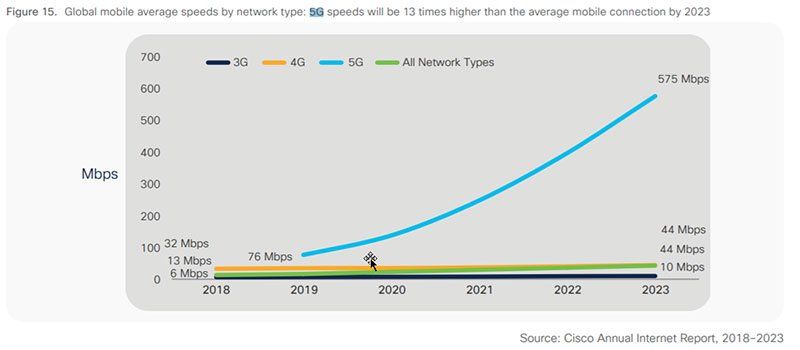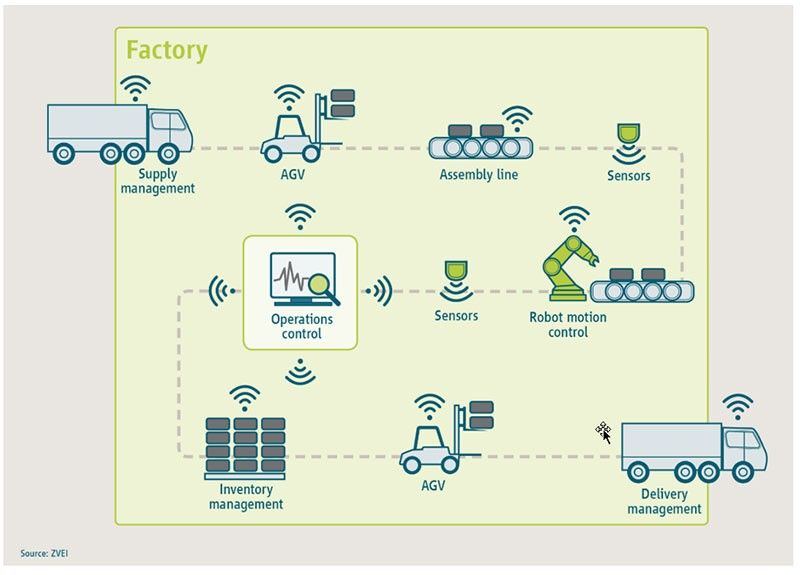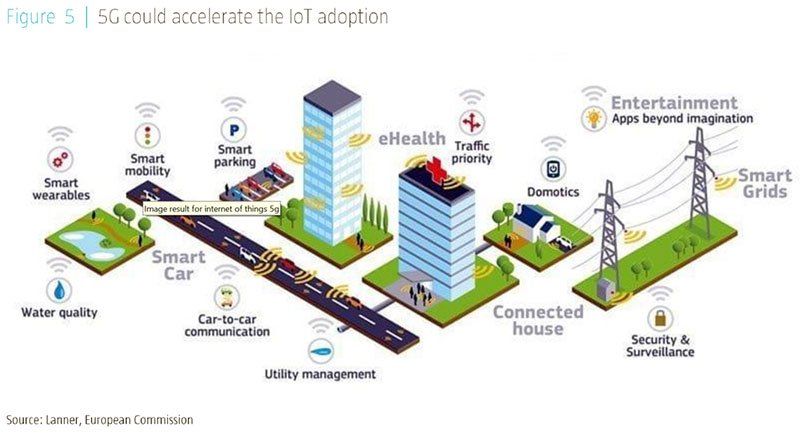
Robeco: Unlocking 5G’s potential
We believe 2021 will be an inflection point for 5G – and a select group of companies will reap the fruits of this powerful shift. In 2020 Apple joined the likes of Samsung and Huawei as it presented its first smartphone capable of connecting to 5G mobile networks. Consumers can now choose from a broad range of 5G smartphones.
18.12.2020 | 12:48 Uhr
Sam Brasser, Analyst
At the same time, telecommunication companies in the US, China, Japan, South Korea, and several countries in Europe are activating their 5G mobile networks. Even though 5G network quality is not yet equal to 4G, the availability of 5G smartphones and activation of 5G networks mean that most of the technological prerequisites for 5G adoption among consumers are being met.
Followers of 5G developments often remark that consumer adoption will remain low because there are no blockbuster use cases that appeal to consumers. We partly agree with that statement, in the sense that 5G won’t be a big hit overnight. But this a chicken-or-egg question? When a technology isn’t widely adopted, companies have a lower incentive to develop use cases for that technology, and when use cases are limited, adoption is likely to be slow.
A similar situation occurred with 4G. To illustrate, mobile applications for video and music streaming, social media, and online shopping were in their infancy before 4G arrived. Data speeds were so low on 3G that user experience for those applications was too unsatisfactory to support broad adoption. Now, of course, they have become mainstream.
A giant leap forward
In a famous commercial from the largest Dutch telecom provider KPN around the introduction of mobile telephony, people on the street were asked in 1998 whether they had a mobile phone. The majority answered they didn’t want one because they could receive phone calls at home, liked to receive mail, or thought it would be annoying to always be reachable.
In 2013, 4G was introduced in the Netherlands, and KPN interviewed the same people. By now they all had mobile phones, and couldn’t do without them, they said. When asked about 4G, they shruggingly replied it wasn’t for them, a waste of time or they were happy with just reading e-mail. One wonders what they will say when asked about 5G. It is much easier to understand in retrospect than to imagine for the future what exactly the impact such a change will have on us.
Do not underestimate the leap forward 5G will bring. 5G’s mobile network technology vastly exceeds its predecessor’s capabilities. Its speed is ten times that of 4G; the network delay (latency) is ten times lower; and it can handle ten times more connections in the same area. Quite impressive. Is 5G making the most of that promises in the real world? Global connectivity measurements show that 5G’s speed is already five to six times higher than 4G’s1. While higher speeds are exciting, we expect improvements in latency and connection density to be the real game changers in terms of enabling entirely new use cases.

It’s about more than just speed
Network upgrades preceding 5G were mainly about speed. In the upgrade to 5G, additional emphasis is put on latency and connection density, to ensure an extremely fast, virtually instantaneous experience for up to a million connections per square kilometer. Cutting latency from 20 to 30 milliseconds to one or two milliseconds has a particularly strong impact on ‘live’ experiences such as streamed video gaming. New latency-critical application such as augmented or virtual reality might become viable on mobile devices as well.
With 5G accelerating the adoption of augmented and virtual reality, the vision of a Metaverse might become reality. This is a real-time, 3D social medium where instead of sending messages and pictures to one another asynchronously, you’re with each other in a virtual world, interacting and having fun experiences which might span anything from purely gaming to purely social experiences.
This vision does not come out of thin air; in fact, it’s backed by Tim Sweeney, founder of Epic Games (creator of the immensely popular game Fortnite). And he’s not alone. Facebook acquired virtual reality (VR) company Oculus in 2014 and has quietly been working on Facebook Horizon, an ever-expanding VR world where you can explore, play, and create.
5G meets the Internet of Things
5G is not just a technology
relevant for data-hungry consumers – it has promising industrial
applications as well, where wireless connectivity is clearly in demand.
As the number of connections increases, wireless connectivity becomes a
more attractive option in terms of cost and time consumption than a
wired option. According to industrial network company HMS, wireless
connectivity accounts for about 6% of the industrial network market in
2019 and is growing 30% annually.
5G’s ability to maintain a very large number of connections in a relatively small area, i.e. connection density, could make it a suitable technology platform for the Internet of Things (IoT). IoT simplifies tracking and controlling moving parts of an industrial operation such as automated guided vehicles, handheld devices, and collaborative robots on mobile platforms, but also components that move through the supply chain and production lines.
In this way, 5G could be a key enabler of further factory automation and a driver of increased efficiency. Its connectivity can increase productivity in industrial operations: using real-time data to communicate with each other, machines can adjust their actions. A current IoT example comes from Ericsson, which has wirelessly connected 1,000 devices in its manufacturing plant in China, enabling real-time monitoring and analysis of production data to guide adjustments to the production plan. Key beneficiaries are IoT companies such as PTC Inc. and connected robotic companies such as ABB and Teradyne.

Robots, cars and machines
5G’s capabilities, high speed, low latency, and high connection density, could accelerate IoT adoption outside factories too. Most new cars now come with an internet connection but are not yet connected to the ‘things’ they encounter such as traffic lights, parking spaces and other cars. A large installed base of things such as sensors, robots, cars and machines interacting through a network such as 5G could generate massive quantities of data.
Companies processing, analyzing, and extracting information from that data create economic value because they improve business decision making for other companies. Large cloud providers such as Google, Microsoft and Amazon already offer solutions for the data created by IoT. Other beneficiaries are data-center owners such as Equinix, CyrusOne and CoreSite.

We believe 2021 could be an inflection point for 5G. Consumers have shown a willingness to subscribe to 5G services. Asia is leading in 5G adoption. In China, over 110m users have subscribed to 5G plans as of June 2020, representing 6.9% of the country’s total user base. South Korea is also seeing increasing adoption, with 5G subscribers now making up 10.6% of the total subscriber base from virtually nothing two years ago. It seems the egg has hatched, and the chick is growing.
Exciting investment opportunities
We can therefore see exciting investment opportunities among owners of digital infrastructure to take action on. For example, densification of our digital infrastructure is needed to ensure 5G reaches its full potential. Networks are being built-out as we write, with 2021 being a key year to increase 5G coverage and quality.
This will give consumers and enterprise customers the user-experience they want. Companies owning digital infrastructure at critical points in the network will benefit, because their assets are increasingly in demand and cannot be avoided when building the 5G network. Selected cellular tower, small cell, fiber cable and data center owners are key beneficiaries at this stage.
As more opportunities slowly become visible, it’s important to bear in mind that as humans, we often underestimate the non-linear change profound technological innovations can bring about. 5G will increase the mobile network’s capabilities with an order of magnitude we cannot imagine.
While use cases are in their infancy, we are confident that innovative growth companies will look at 5G, see its capabilities, and develop use-cases and applications for it. Comfortably invested in digital infrastructure now, we are excited to see which companies are able to unlock 5G’s potential for all our benefits.
1 Opensignal. Date: 2020.




Diesen Beitrag teilen: